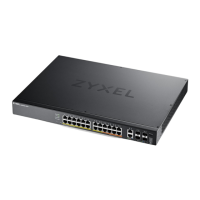
Do you have a question about the ZyXEL Communications XGS2220 Series and is the answer not in the manual?
| Brand | ZyXEL Communications |
|---|---|
| Model | XGS2220 Series |
| Category | Switch |
| Language | English |
Details how warnings and notes are presented in the guide, emphasizing warnings about potential harm to the user or device.
Explains conventions used for referring to models, product labels, screen names, field labels, and navigation paths using angle brackets.
Describes generic icons used in figures, noting that the Switch icon is not an exact representation of the device.
Introduces the main features and applications of the Switch, including model series and management methods.
Explains the support for 10 Gigabit ports and Multi-Gigabit (IEEE 802.3bz) Ethernet connections.
Describes NebulaFlex for standalone or cloud management modes, including access via Web Configurator or Nebula Control Center.
Details how to change the Switch's management mode, covering transitions from Standalone to Nebula Cloud Management.
Introduces the Zyxel One Network (ZON) Utility for network device deployment and management.
Explains the Networked AV mode for simplifying AVoIP application configuration.
Describes the Power Sourcing Equipment (PSE) function, PoE standards (802.3af, 802.3at, 802.3bt), and PoE features by model.
Provides examples of Switch usage in various network environments, including PoE, Backbone, and Bridging.
Outlines the methods to manage the Switch, including NCC, Web Configurator, CLI, FTP, and SNMP.
Provides recommendations for managing the Switch securely and effectively, such as changing passwords and backing up configurations.
Describes the scenarios for installing the Switch, including desktop placement and rack mounting.
Provides essential safety precautions before using the Switch, covering clearance, ventilation, and handling hot surfaces.
Details the step-by-step procedure for freestanding installation, including cleaning and removing adhesive backing.
Explains how to mount the Switch on a standard EIA rack using a rack-mounting kit, including requirements and precautions.
Illustrates the front panels of the Switch and describes the connectors and their purposes.
Details the 10/100/1000Base-T auto-negotiating Ethernet ports and their capabilities.
Explains the SFP/SFP+ slots for connecting transceivers and the handling precautions for static-sensitive modules.
Describes the Console Port, a USB Type C connector used for troubleshooting only.
Shows the rear panels of the Switch, identifying key components like grounding and power connections.
Provides safety measures for grounding the Switch to prevent electric shock and equipment damage.
Details how to connect the AC power, including power cord requirements and installing a retainer clip.
Explains the meaning of the various LEDs on the Switch for status indication and troubleshooting.
Introduces the Web Configurator as an HTML-based interface for system setup and management via browser.
Guides users through the process of accessing the Web Configurator, including default IP addresses and login credentials.
Describes the ZON Utility for network device deployment and management, including requirements and how to run it.
Explains the Networked AV Mode Wizard for configuring AVoIP settings, including Basic and Advanced options.
Details the Setup Wizard's components: Basic, Protection, VLAN, and QoS settings for network configuration.
Illustrates the navigation components of the Web Configurator screen, explaining the function of menus and quick links.
Provides an overview of initial setup steps for an example network, including VLAN creation and IP configuration.
Explains how to create a VLAN and configure port membership, specifically port 1 as a member of VLAN 2.
Details how to use PVID to add a tag to incoming untagged frames on a port for VLAN forwarding.
Guides on configuring the Switch's management IP address, including using DHCP or static IP for different subnets.
Introduces examples of using the Web Configurator for switch setup, covering DHCP Snooping, Relay, and Auto Configuration.
Provides a tutorial on configuring DHCPv4 Snooping, including VLAN setup and trusted port settings.
Explains how to configure DHCPv4 Relay to forward client requests to a specific DHCP server.
Guides on setting up configurations for auto-configuration via DHCP and TFTP servers upon switch reboot.
Describes the restructured Web Configurator user interface, highlighting visualized port status and cloud control.
Details the DASHBOARD screen, which displays general device information, system status, and resource usage.
Provides visualized port status for monitoring, showing link speed and connection status via color-coded ports.
Explains the Quick Link section for accessing specific configuration screens via shortcuts and customizing them.
Introduces the ARP Table for viewing IP-to-MAC address mappings and managing dynamic ARP entries.
Explains the IP Table screen, showing how packets are forwarded or filtered across Switch ports.
Introduces the IPv6 neighbor table for viewing IPv6 neighbor information and managing devices.
Discusses the MAC Table screen, showing frame forwarding/filtering based on MAC addresses and VLAN groups.
Explains the Neighbor screen for viewing and managing Switch's neighboring devices using LLDP.
Introduces the IPv6 Path MTU table for discovering the minimum link MTU of all links in a path.
Displays port statistical summary with links to each port showing statistical details for monitoring.
Introduces the IPv4/IPv6 routing tables, which record routing information of the best path to destinations.
Provides general system information and hardware status of the Switch, including firmware version and temperature.
Explains how log messages store system history information for viewing and troubleshooting.
Overview of Zyxel Nebula Control Center (NCC) for remote management and monitoring of Zyxel Nebula APs, switches, and gateways.
Explains how to configure general settings for the Switch, such as system name, location, and time.
Introduces Fan Control for SFP transceiver temperature and hardware monitoring features.
Details how to create virtual interfaces for interface-based configurations, including physical and virtual interfaces.
Covers IP settings configuration and IP interface setup on the Switch using IP Setup screens.
Introduces IPv6 screens for configuring global IPv6 settings, interfaces, and addresses.
Explains how to set up login accounts for up to five users, including administrator and non-administrator privileges.
Shows how to set up SNMP settings for management, including general settings, users, and trap groups.
Details basic switch configuration, including VLAN type, switching protocols, and MAC learning aging time.
Explains how to configure system logging settings and a list of external syslog servers.
Describes how to set a time range for time-oriented features like Classifier ACL rules.
Explains how to configure IP settings and set up IP interfaces on the Switch using IP Setup screens.
Details how to view current IP interfaces and DNS server settings on the Switch.
Guides on configuring default gateway, DNS server, and adding IP domains for network management.
Explains how to enable communication between the Switch and NCC through a proxy server.
Introduces IPv6 screens for configuring global IPv6 settings, interfaces, and addresses.
Details how to view the IPv6 table and DNS server information.
Guides on configuring global IPv6 settings.
Explains how to view and configure IPv6 interfaces.
Covers viewing and configuring the interface’s link-local address and default gateway.
Guides on viewing and configuring the interface’s IPv6 global addresses.
Details how to configure neighbor discovery settings for each interface.
Explains how to configure router discovery settings for each interface.
Guides on configuring the Switch’s IPv6 prefix list for each interface.
Details how to configure static IPv6 neighbor entries in the Switch’s IPv6 neighbor table.
Explains how to configure the Switch’s DHCP settings when acting as a DHCPv6 client.
Describes how to set up login accounts for up to five users, including administrator and non-administrator privileges.
Introduces SNMP settings for management, covering general settings and configuration.
Guides on configuring SNMP settings for management.
Explains how to create SNMP users for authentication using SNMP v3 and associate them to SNMP groups.
Details how to specify types of SNMP traps to be sent to each SNMP manager.
Explains how to set whether traps received on ports would be sent to the SNMP manager.
Provides technical background information on topics discussed in the chapter, including SNMP commands and security.
Details basic switch configuration, including VLAN type, switching protocols, and MAC learning aging time.
Explains VLANs as a way to partition a physical network into multiple logical networks for isolation and security.
Guides on basic switch setup, including VLAN type selection and its impact on VLAN setup screens.
Explains the Syslog screens for sending event notification messages to syslog servers for collection.
Details configuring system logging settings and a list of external syslog servers.
Explains setting time ranges for time-oriented features like Classifier ACL rules for scheduling configuration activity.
Guides on setting up absolute or periodic time ranges for scheduling configurations.
Introduces Automatic PD Recovery for restarting PDs like IP cameras that may freeze or slow down.
Explains how to enable automatic PD recovery and configure detection methods like LLDP or ping.
Provides steps to activate the automatic PD recovery feature.
Introduces Flex Links, a pair of primary and backup links for layer-2 interface backup.
Explains how to view the flex link status on the Switch.
Guides on configuring flex links for backup links on the Switch.
Explains how Green Ethernet reduces switch port power consumption via EEE, Auto Power Down, and Short Reach.
Details how to configure the Switch to reduce port power consumption.
Shows how to logically aggregate physical links to form one logical, higher-bandwidth link.
Explains how to view configured trunk group ports and their current data transmission status.
Guides on configuring static link aggregation.
Details how to enable Link Aggregation Control Protocol (LACP) for dynamic link aggregation.
Provides technical background information on topics discussed in the chapter, including static trunking examples.
Explains LLDP as a layer 2 protocol for advertising device identity and capabilities on the network.
Introduces LLDP-MED for enhanced discovery capabilities for media endpoint devices like VoIP applications.
Displays a summary of LLDP status on the Switch, including basic TLVs and port information.
Shows a summary of LLDP status for each LLDP connection to a neighboring Switch.
Guides on configuring global LLDP settings on the Switch, including transmit interval and hold time.
Explains how to configure basic TLV settings for LLDP, including management address and port description.
Details how to configure organization-specific TLV settings for LLDP.
Guides on configuring LLDP-MED parameters.
Explains how to configure LLDP-MED network policy parameters.
Details how to configure LLDP-MED location parameters.
Introduces Ethernet OAM as a link monitoring protocol using OAM PDUs for link status information.
Explains how to view the configuration of ports on which Ethernet OAM is enabled.
Guides on enabling Ethernet OAM on the Switch and ports and configuring related settings.
Details how to perform a remote loopback test.
Displays PoE status, including power management mode, total power, usage, and port status.
Explains how to set PoE power management mode, priority levels, power-up mode, and maximum power for connected PDs.
Guides on applying a schedule to the ports for PoE power management based on time.
Details how to configure Switch port settings such as speed, duplex, flow control, and 802.1p priority.
Introduces Zyxel Unidirectional Link Detection (ZULD) as a layer-2 protocol to detect and disable physical one-way links.
Explains how to view details of unidirectional and bidirectional links discovered by ZULD.
Guides on enabling ZULD on a port, configuring a mode, and setting the probe time.
Explains how to configure layer 2 protocol tunneling on the Switch, including MAC address encapsulation.
Describes using the Layer 2 Protocol Tunneling screen to enable tunneling and specify MAC addresses.
Explains Layer 2 protocol tunneling (L2PT) used on service provider's edge devices for tunneling STP, CDP, and VTP packets.
Guides on configuring Layer 2 Protocol Tunneling, including modes like Access and Tunnel.
Explains how to configure the Switch to guard against loops on the network edge.
Describes using the Loop Guard screen to enable loop guard on the Switch and in specific ports.
Explains how loop guard handles loop problems on the network edge, including behavior in loop states.
Guides on enabling and configuring loop guard on the Switch and its ports.
Explains MAC pinning for setting port priority over other ports in MAC address learning for enhanced security.
Guides on enabling MAC pinning on the Switch and on specific ports.
Discusses port mirroring setup screens for copying traffic flow to a monitor port for examination.
Provides concepts on Mirroring to help configure screens, supporting local and remote port mirroring.
Explains how to select a monitor port and specify traffic flow to be copied to the monitor port.
Explains various multicast features, including IGMP and MLD protocols.
Details how to use IPv4 Multicast Status, IGMP Snooping, and IGMP Filtering Profile screens.
Explains how to use IPv6 Multicast Status, MLD Snooping-proxy, and MLD Snooping-proxy VLAN screens.
Guides on using MVR screens to create multicast VLANs and select receiver and source ports.
Provides concepts on Multicasting, including IP Multicast Addresses, IGMP Filtering, and IGMP Snooping.
Displays IPv4 multicast group information.
Explains how to enable IGMP snooping to forward group multicast traffic only to member ports.
Guides on enabling IGMP snooping on VLANs and specifying the default DHCP server location.
Specifies a range of multicast groups that clients can join.
Discusses configuring static multicast forwarding rules based on MAC addresses or IPv4 addresses.
Guides on viewing and configuring static multicast MAC addresses for ports to receive multicast streams.
Explains how to configure static multicast IPv4 addresses for ports to receive multicast streams.
Describes how the Switch provides PPPoE termination server with subscriber line specific information for client identification.
Guides on configuring the Switch to give PPPoE termination server additional subscriber information.
Details specifying whether individual ports are trusted or untrusted for PPPoE discovery packets.
Explains how to configure PPPoE IA settings that apply to a specific VLAN on a port.
Guides on setting whether the PPPoE Intermediate Agent is enabled on a VLAN.
Explains DiffServ (Differentiated Services) as a CoS model for marking packets for specific per-hop treatment.
Details using the Diffserv screen to activate marking rules or IEEE 802.1p priority mapping.
Guides on activating DiffServ to apply marking rules or IEEE 802.1p priority mapping on selected ports.
Explains how to configure DSCP to IEEE 802.1p mapping to prioritize traffic based on DSCP value.
Guides on changing the DSCP-IEEE 802.1p mapping.
Introduces queuing methods supported for performance degradation during network congestion.
Explains using the Queuing Method screen to set priorities for Switch queues.
Guides on setting priorities for the Switch queues to distribute bandwidth across traffic queues.
Explains IEEE 802.1p traffic types and priority level-to-physical queue mapping.
Guides on assigning priority levels to each queue.
Shows how to cap maximum bandwidth using the Bandwidth Control screen.
Explains using the Bandwidth Control screen to limit bandwidth for traffic.
Defines Committed Information Rate (CIR) and Peak Information Rate (PIR) for traffic flow on a port.
Guides on accessing the Bandwidth Control screen to configure settings.
Explains sFlow as a technology for monitoring switched networks and sending data to an sFlow collector.
Guides on configuring sFlow port settings.
Details how to configure sFlow collectors for traffic analysis.
Explains Spanning Tree Protocol (STP), RSTP, and MSTP standards supported by the Switch.
Guides on viewing STP status in different modes and activating STP standards.
Provides concepts on STP for configuring screens, including RSTP terminology and port states.
Details how the STP status screen changes based on the chosen standard (RSTP, MRSTP, MSTP).
Explains the three Auto path-cost Modes for automatically setting path costs based on link speeds.
Shows the RSTP status screen, available after activating RSTP.
Guides on configuring RSTP settings.
Details the MRSTP status screen, available after activating MRSTP.
Guides on configuring MRSTP settings.
Shows the MSTP status screen, available after activating MSTP.
Guides on configuring MSTP settings.
Details how to configure MSTP ports.
Provides technical background information on STP, including MSTP network examples and MST regions.
Discusses MAC address port filtering based on source/destination MAC addresses and VLAN ID.
Guides on viewing and configuring rules for traffic filtering based on MAC addresses.
Discusses configuring forwarding rules based on MAC addresses of network devices.
Explains using the Static MAC Forwarding screen to assign static MAC addresses for a port.
Guides on setting up static MAC address rules for ports, which do not age out.
Shows how to configure 802.1Q tagged and port-based VLANs.
Details using VLAN Status, VLAN Details, Static VLAN Setup, and VLAN Port Setup screens.
Provides information about VLAN and how to configure the screens.
Explains tagged VLANs using explicit tags (VLAN ID) in the MAC header for frame identification.
Describes GARP and GVRP protocols for automatic VLAN membership registration across switches.
Explains enabling VLAN Trunking on ports to allow frames belonging to unknown VLAN groups to pass through.
Guides on viewing and searching all static VLAN groups.
Details how to view and configure a static VLAN for the Switch.
Explains how to configure static VLAN (IEEE 802.1Q) settings on a port.
Guides on configuring GVRP settings on a port.
Describes grouping traffic into logical VLANs based on the source IP subnet.
Explains grouping traffic into logical VLANs based on the protocol specified.
Guides on configuring Protocol Based VLAN setup.
Explains Voice VLAN for allocating traffic with defined priority, separating voice and data traffic.
Details assigning priority to MAC-based VLANs and defining MAC to VLAN mapping tables.
Explains setting up VLANs based on source MAC address and specifying vendor ID to VLAN mapping.
Guides on configuring port-based VLANs where packet forwarding is based on destination MAC address.
Explains selecting Port Based as VLAN Type and configuring port settings.
Introduces VLAN Isolation for preventing communication between ports within a VLAN.
Guides on configuring VLAN Isolation to specify ports not isolated in a promiscuous port list.
Explains how VLAN mapping enables the Switch to map VLAN IDs and priorities of received packets.
Guides on enabling VLAN mapping on the Switch.
Details how to view and configure VLAN mapping rules.
Shows how to configure VLAN stacking to distinguish multiple customer VLANs within a network.
Explains the three VLAN stacking port roles: Normal, Access, and Tunnel.
Details the VLAN tag format for service provider VLAN stacking or customer IEEE 802.1Q.
Guides on configuring VLAN stacking.
Explains how Port-Based Q-in-Q treats all frames on the same port as the same VLAN flows.
Details how Selective Q-in-Q allows adding different outer VLAN tags to incoming frames.
Introduces Address Resolution Protocol (ARP) for mapping IP addresses to MAC addresses.
Explains using ARP Learning and Static ARP screens for ARP configuration.
Provides concepts on ARP and how ARP works.
Guides on configuring each port’s ARP learning mode.
Explains how to view and configure static ARP entries that will display in the MONITOR > ARP Table screen.
Explains the DHCP feature, allowing computers to obtain TCP/IP configuration from a server.
Details how to display the relay mode and status.
Guides on viewing and configuring DHCPv4 option 82 profiles.
Explains how to configure global DHCPv4 relay.
Details how to configure DHCP settings based on the VLAN domain of DHCP clients.
Explains how to enable and configure DHCPv6 relay settings.
Guides on specifying whether ports are trusted or untrusted for DHCP packets.
Shows how to configure static routes for IP communication with management computers.
Guides on configuring and enabling an IPv4 static route.
Explains how to configure and enable an IPv6 static route.
Describes configuring authentication, authorization, and accounting settings on the Switch.
Guides on configuring RADIUS server settings.
Explains how to configure TACACS+ server settings.
Details configuring authentication, authorization, and accounting settings.
Provides technical background on AAA, including Vendor Specific Attributes and Tunnel Protocol Attribute.
Describes how to control access to the Switch, including console, Telnet, SSH, FTP, Web, and SNMP access.
Allows deciding which services may be used to access the Switch and configuring default service ports.
Explains specifying trusted computers for administrator access to manage the Switch.
Details encrypting all passwords configured in the Switch for security.
Provides technical background on SSH and HTTPS, including examples and implementation details.
Introduces packet classifier configuration on the Switch and discusses Quality of Service (QoS).
Shows classifiers configured on the Switch and match counts for traffic rules.
Guides on defining classifiers and specifying actions for traffic matching the rules.
Explains configuring match order and enabling logging on the Switch.
Shows how to configure policy rules to ensure traffic flows receive requested treatment.
Guides on using the Policy Rule screen to enable policy and display active classifiers.
Explains DiffServ as a CoS model for marking packets for specific per-hop treatment.
Details the DS field, DSCP field, and how they define service levels and per-hop behavior.
Guides on enabling policy and displaying active classifiers.
Introduces ARP scan and how Anti-arpscan detects unusual ARP activity to block suspicious hosts.
Explains using Anti-Arpscan Status, Host Status, Setup, and Trust Host screens.
Provides information on setting uplink ports as trusted and handling ARP packet rates.
Shows which ports are trusted, forwarding traffic, or disabled.
Details viewing blocked hosts and unblocking them.
Guides on enabling Anti-Arpscan, setting thresholds, and configuring trusted/untrusted ports.
Explains creating or removing trusted hosts identified by IP address and subnet mask.
Introduces BPDU Guard feature to prevent STP topology changes by blocking ports with detected BPDUs.
Shows whether BPDU guard is enabled on the Switch and the port status.
Guides on turning on the BPDU guard feature on the Switch and ports.
Introduces the storm control feature to limit broadcast, multicast, and DLF packets per second.
Guides on limiting broadcast, multicast, and DLF packets received per second on ports.
Explains configuring rate limit for control packets and actions on detected errors.
Details CPU protection feature to limit control packets to prevent CPU overload.
Explains how to automatically undo actions after errors are gone.
Guides on using Errdisable Status, CPU Protection, Errdisable Detect, and Errdisable Recovery screens.
Shows detected control packet rate limits and port disable status.
Details limiting the maximum number of control packets received or transmitted on a port.
Explains configuring the Switch to detect control packet rate limits and configure actions.
Guides on configuring the Switch to automatically undo actions after errors are gone.
Introduces IP source guard using a binding table to distinguish authorized/unauthorized DHCP and ARP packets.
Explains using IPv4 Source Guard and Static Binding screens for DHCP snooping and ARP inspection.
Provides information on how the Switch builds the binding table using DHCP snooping and static bindings.
Details looking at current bindings for DHCP snooping and ARP inspection.
Guides on managing static bindings for DHCP snooping and ARP inspection.
Explains how DHCP snooping builds a binding table and filters unauthorized DHCP packets.
Guides on using DHCP Snooping Status, Setup, Port Setup, VLAN Setup, and VLAN Port Setup screens.
Details looking at various statistics about the DHCP snooping database.
Explains enabling DHCP snooping, specifying the default DHCP server VLAN, and configuring the database.
Guides on specifying trusted or untrusted ports for DHCP snooping and setting packet rates.
Details enabling DHCP snooping on each VLAN and specifying option 82 information.
Explains applying different DHCP option 82 profiles to ports in a VLAN.
Provides background on DHCP snooping, including trusted vs. untrusted ports and database configuration.
Shows the current list of MAC address filters created due to unauthorized ARP packets.
Details statistics about ARP packets in each VLAN.
Explains how to look at log messages generated by ARP packets.
Guides on enabling ARP inspection, configuring log length, and global settings.
Details specifying trusted/untrusted ports for ARP inspection and setting packet rates.
Explains enabling ARP inspection on each VLAN and specifying log message generation.
Introduces IPv6 source guard for validating source of IPv6 traffic using a binding table.
Details looking at current IPv6 dynamic and static bindings.
Guides on viewing or configuring IPv6 source guard binding table entries and managing static bindings.
Explains how to forward valid IPv6 addresses/prefixes and block traffic from link-local addresses.
Details applying configured IPv6 source guard policies to specified ports.
Guides on dynamically creating IPv6 source guard binding tables using DHCPv6 snooping policy.
Explains enabling DHCPv6 snooping policy on a specific VLAN interface.
Details specifying trusted ports for DHCPv6 snooping.
Provides technical background on ARP inspection, including man-in-the-middle attack prevention.
Describes IEEE 802.1x, MAC, Guest VLAN, and Compound authentication methods.
Guides on activating IEEE 802.1x, MAC Authentication, and Guest VLAN.
Explains IEEE 802.1x Authentication process and MAC Authentication.
Details how to activate IEEE 802.1x security.
Guides on activating MAC authentication.
Explains enabling and assigning a guest VLAN to a port for non-authenticated users.
Describes allowing network access for clients passing IEEE 802.1x OR MAC authentication, or both.
Provides technical background on IEEE 802.1x, RADIUS, EAP, and EAPOL.
Shows how to set up port security.
Explains port security allowing packets with learned or static MAC addresses through a port.
Guides on configuring port security.
Explains how to configure screens for maintaining firmware and configuration files.
Lists actions for maintaining the Switch, including certificates, cluster management, and configuration backup.
Details how to view HTTPS certificate details and import CA-signed certificates.
Provides technical background on FTP command line and filename conventions.
Explains Cluster Management for managing switches through a cluster manager.
Shows the role of the Switch within a cluster and access to cluster member Web Configurators.
Guides on configuring clustering management.
Details how to restore a previously saved configuration file from a computer to the Switch.
Explains how to back up the Switch configuration to a computer.
Guides on downloading an auto configuration file automatically when rebooting the Switch.
Explains how to remove the running configuration on the Switch.
Details how to save the current configuration settings permanently.
Shows how to copy basic and advanced settings from a source port to destination ports.
Explains how to use the Diagnostic screen for ping, traceroute, port tests, and location.
Guides on upgrading the Switch’s firmware through Web Configurator or NCC.
Details how to restart the Switch without turning off power and load configurations.
Explains the Tech-Support feature for logging useful information for issue analysis.
Introduces Networked AV mode for setting up and managing audio-video traffic.
Explains how to access online help for Networked AV mode screens.
Describes the SUMMARY screen for viewing port status, connected ports, and Nebula Cloud Control status.
Introduces the MONITOR screens for viewing system status.
Guides on checking firmware version and monitoring Switch temperature.
Details how to view general system information, including firmware version and hardware status.
Introduces the SYSTEM screens for configuration.
Explains using Cloud Management, General Setup, IP Setup, and Logins screens.
Describes Zyxel Nebula Control Center (NCC) for remote management and monitoring.
Guides on configuring general settings like system name and time.
Details configuring default gateway, DNS server, and adding IP domains.
Explains setting up login accounts for administrator and users.
Guides on configuring SNMP settings.
Explains creating SNMP users for authentication with managers using SNMP v3.
Details specifying types of SNMP traps to be sent to SNMP managers.
Explains setting whether traps received on ports are sent to the SNMP manager.
Introduces the PORT screens for port configuration.
Shows how to logically aggregate physical links for higher bandwidth.
Explains how to view configured trunk group ports and their status.
Guides on enabling static link aggregation.
Details enabling Link Aggregation Control Protocol (LACP) for dynamic link aggregation.
Displays PoE status, including power management mode, total power, and port status.
Explains setting PoE power management mode, priority levels, and power-up mode.
Guides on configuring Switch port settings like speed, duplex, and priority.
Introduces the SWITCHING screens.
Explains port mirroring for copying traffic flow to a monitor port for examination.
Shows how to configure various multicast features, including IGMP and MLD protocols.
Displays IPv4 multicast group information.
Explains enabling IGMP snooping to learn multicast group membership.
Guides on enabling IGMP snooping on VLANs and specifying fixed or auto mode.
Specifies a range of multicast groups that clients can join.
Shows how to configure 802.1Q tagged and port-based VLANs.
Explains how to view and search all static VLAN groups.
Guides on viewing and configuring a static VLAN for the Switch.
Details how to configure static VLAN (IEEE 802.1Q) settings on a port.
Introduces the SECURITY screens.
Describes how to control access to the Switch.
Allows deciding which services may be used to access the Switch.
Explains specifying trusted computers for administrator access.
Details configuring storm control to limit broadcast, multicast, and DLF packets.
Explains how to configure screens for maintaining firmware and configuration files.
Guides on restoring, backing up, saving configurations, firmware upgrades, rebooting, and tech-support.
Details how to restore a previously saved configuration file.
Explains how to back up the Switch configuration.
Guides on saving the current configuration settings permanently.
Explains upgrading the Switch’s firmware through Web Configurator or NCC.
Details how to restart the Switch and load different configurations.
Explains the Tech-Support feature for logging useful information for issue analysis.
Shows how to configure static routes for IP communication with management computers.
Guides on configuring and enabling an IPv4 static route.
Explains how to configure and enable an IPv6 static route.
Describes how to control access to the Switch, including console, Telnet, SSH, FTP, Web, and SNMP access.
Allows deciding which services may be used to access the Switch and configuring default service ports.
Explains specifying trusted computers for administrator access.
Details encrypting all passwords configured in the Switch for security.
Provides technical background on SSH and HTTPS, including examples and implementation details.
Introduces packet classifier configuration on the Switch and discusses Quality of Service (QoS).
Shows classifiers configured on the Switch and match counts for traffic rules.
Guides on defining classifiers and specifying actions for traffic matching the rules.
Explains configuring match order and enabling logging on the Switch.
Shows how to configure policy rules to ensure traffic flows receive requested treatment.
Guides on using the Policy Rule screen to enable policy and display active classifiers.
Explains DiffServ as a CoS model for marking packets for specific per-hop treatment.
Details the DS field, DSCP field, and how they define service levels and per-hop behavior.
Guides on enabling policy and displaying active classifiers.
Introduces ARP scan and how Anti-arpscan detects unusual ARP activity to block suspicious hosts.
Explains using Anti-Arpscan Status, Host Status, Setup, and Trust Host screens.
Provides information on setting uplink ports as trusted and handling ARP packet rates.
Shows which ports are trusted, forwarding traffic, or disabled.
Details viewing blocked hosts and unblocking them.
Guides on enabling Anti-Arpscan, setting thresholds, and configuring trusted/untrusted ports.
Explains creating or removing trusted hosts identified by IP address and subnet mask.
Introduces BPDU Guard feature to prevent STP topology changes by blocking ports with detected BPDUs.
Shows whether BPDU guard is enabled on the Switch and the port status.
Guides on turning on the BPDU guard feature on the Switch and ports.
Introduces the storm control feature to limit broadcast, multicast, and DLF packets per second.
Guides on limiting broadcast, multicast, and DLF packets received per second on ports.
Explains configuring rate limit for control packets and actions on detected errors.
Details CPU protection feature to limit control packets to prevent CPU overload.
Explains how to automatically undo actions after errors are gone.
Guides on using Errdisable Status, CPU Protection, Errdisable Detect, and Errdisable Recovery screens.
Shows detected control packet rate limits and port disable status.
Details limiting the maximum number of control packets received or transmitted on a port.
Explains configuring the Switch to detect control packet rate limits and configure actions.
Guides on configuring the Switch to automatically undo actions after errors are gone.
Introduces IP source guard using a binding table to distinguish authorized/unauthorized DHCP and ARP packets.
Explains using IPv4 Source Guard and Static Binding screens for DHCP snooping and ARP inspection.
Provides information on how the Switch builds the binding table using DHCP snooping and static bindings.
Details looking at current bindings for DHCP snooping and ARP inspection.
Guides on managing static bindings for DHCP snooping and ARP inspection.
Explains how DHCP snooping builds a binding table and filters unauthorized DHCP packets.
Guides on using DHCP Snooping Status, Setup, Port Setup, VLAN Setup, and VLAN Port Setup screens.
Details looking at various statistics about the DHCP snooping database.
Explains enabling DHCP snooping, specifying the default DHCP server VLAN, and configuring the database.
Guides on specifying trusted or untrusted ports for DHCP snooping and setting packet rates.
Details enabling DHCP snooping on each VLAN and specifying option 82 information.
Explains applying different DHCP option 82 profiles to ports in a VLAN.
Provides background on DHCP snooping, including trusted vs. untrusted ports and database configuration.
Shows the current list of MAC address filters created due to unauthorized ARP packets.
Details statistics about ARP packets in each VLAN.
Explains how to look at log messages generated by ARP packets.
Guides on enabling ARP inspection, configuring log length, and global settings.
Details specifying trusted/untrusted ports for ARP inspection and setting packet rates.
Explains enabling ARP inspection on each VLAN and specifying log message generation.
Introduces IPv6 source guard for validating source of IPv6 traffic using a binding table.
Details looking at current IPv6 dynamic and static bindings.
Guides on viewing or configuring IPv6 source guard binding table entries and managing static bindings.
Explains how to forward valid IPv6 addresses/prefixes and block traffic from link-local addresses.
Details applying configured IPv6 source guard policies to specified ports.
Guides on dynamically creating IPv6 source guard binding tables using DHCPv6 snooping policy.
Explains enabling DHCPv6 snooping policy on a specific VLAN interface.
Details specifying trusted ports for DHCPv6 snooping.
Provides technical background on ARP inspection, including man-in-the-middle attack prevention.
Describes IEEE 802.1x, MAC, Guest VLAN, and Compound authentication methods.
Guides on activating IEEE 802.1x, MAC Authentication, and Guest VLAN.
Explains IEEE 802.1x Authentication process and MAC Authentication.
Details how to activate IEEE 802.1x security.
Guides on activating MAC authentication.
Explains enabling and assigning a guest VLAN to a port for non-authenticated users.
Describes allowing network access for clients passing IEEE 802.1x OR MAC authentication, or both.
Provides technical background on IEEE 802.1x, RADIUS, EAP, and EAPOL.
Shows how to set up port security.
Explains port security allowing packets with learned or static MAC addresses through a port.
Guides on configuring port security.
Explains how to configure screens for maintaining firmware and configuration files.
Lists actions for maintaining the Switch, including certificates, cluster management, and configuration backup.
Details how to view HTTPS certificate details and import CA-signed certificates.
Provides technical background on FTP command line and filename conventions.
Explains Cluster Management for managing switches through a cluster manager.
Shows the role of the Switch within a cluster and access to cluster member Web Configurators.
Guides on configuring clustering management.
Details how to restore a previously saved configuration file from a computer to the Switch.
Explains how to back up the Switch configuration to a computer.
Guides on downloading an auto configuration file automatically when rebooting the Switch.
Explains how to remove the running configuration on the Switch.
Details how to save the current configuration settings permanently.
Shows how to copy basic and advanced settings from a source port to destination ports.
Explains how to use the Diagnostic screen for ping, traceroute, port tests, and location.
Guides on upgrading the Switch’s firmware through Web Configurator or NCC.
Details how to restart the Switch and load different configurations.
Explains the Tech-Support feature for logging useful information for issue analysis.
Introduces Networked AV mode for setting up and managing audio-video traffic.
Explains how to access online help for Networked AV mode screens.
Describes the SUMMARY screen for viewing port status, connected ports, and Nebula Cloud Control status.
Introduces the MONITOR screens for viewing system status.
Guides on checking firmware version and monitoring Switch temperature.
Details how to view general system information, including firmware version and hardware status.
Introduces the SYSTEM screens for configuration.
Explains using Cloud Management, General Setup, IP Setup, and Logins screens.
Describes Zyxel Nebula Control Center (NCC) for remote management and monitoring.
Guides on configuring general settings like system name and time.
Details configuring default gateway, DNS server, and adding IP domains.
Explains setting up login accounts for administrator and users.
Guides on configuring SNMP settings.
Explains creating SNMP users for authentication with managers using SNMP v3.
Details specifying types of SNMP traps to be sent to SNMP managers.
Explains setting whether traps received on ports are sent to the SNMP manager.
Introduces the PORT screens for port configuration.
Shows how to logically aggregate physical links for higher bandwidth.
Explains how to view configured trunk group ports and their status.
Guides on enabling static link aggregation.
Details enabling Link Aggregation Control Protocol (LACP) for dynamic link aggregation.
Displays PoE status, including power management mode, total power, and port status.
Explains setting PoE power management mode, priority levels, and power-up mode.
Guides on configuring Switch port settings like speed, duplex, and priority.
Introduces the SWITCHING screens.
Explains port mirroring for copying traffic flow to a monitor port for examination.
Shows how to configure various multicast features, including IGMP and MLD protocols.
Displays IPv4 multicast group information.
Explains enabling IGMP snooping to forward group multicast traffic only to member ports.
Guides on enabling IGMP snooping on VLANs and specifying fixed or auto mode.
Specifies a range of multicast groups that clients can join.
Shows how to configure 802.1Q tagged and port-based VLANs.
Explains how to view and search all static VLAN groups.
Guides on viewing and configuring a static VLAN for the Switch.
Details how to configure static VLAN (IEEE 802.1Q) settings on a port.
Introduces the SECURITY screens.
Describes how to control access to the Switch.
Allows deciding which services may be used to access the Switch.
Explains specifying trusted computers for administrator access.
Details configuring storm control to limit broadcast, multicast, and DLF packets.
Explains how to configure screens for maintaining firmware and configuration files.
Guides on restoring, backing up, saving configurations, firmware upgrades, rebooting, and tech-support.
Details how to restore a previously saved configuration file from a computer to the Switch.
Explains how to back up the Switch configuration to a computer.
Guides on saving the current configuration settings permanently.
Explains upgrading the Switch’s firmware through Web Configurator or NCC.
Details how to restart the Switch and load different configurations.
Explains the Tech-Support feature for logging useful information for issue analysis.
Addresses issues with the Switch not turning on or LEDs not behaving as expected.
Troubleshoots problems with logging into the Switch, including forgotten credentials or concurrent session limits.
Addresses issues related to lost configuration settings after restarting the Switch.


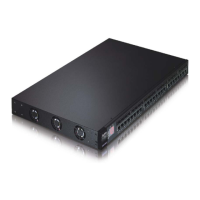
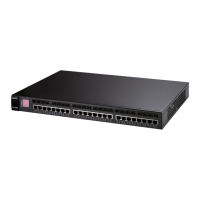
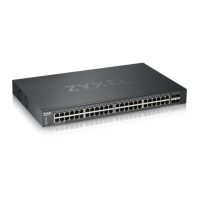
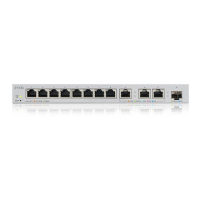
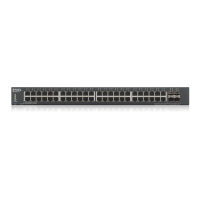

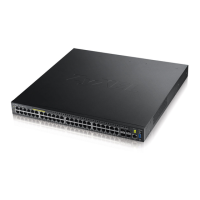
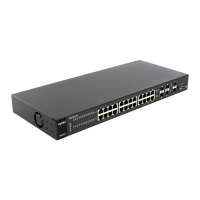
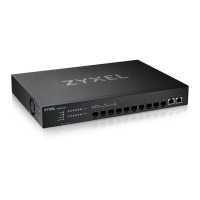
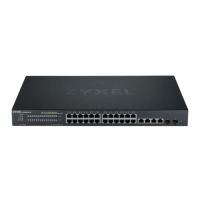
